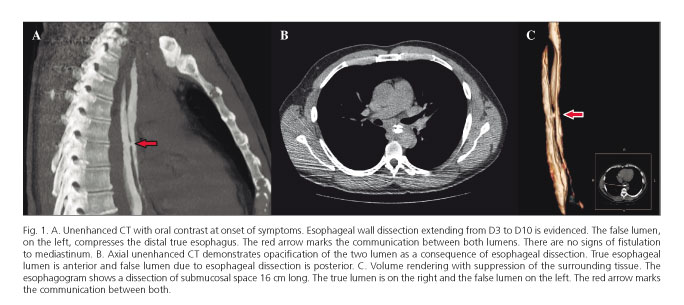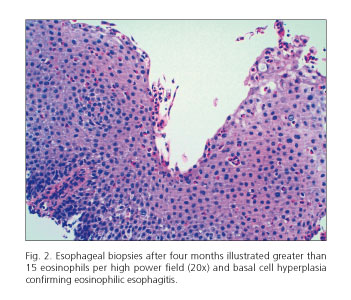Meu SciELO
Serviços Personalizados
Journal
Artigo
Indicadores
-
 Citado por SciELO
Citado por SciELO -
 Acessos
Acessos
Links relacionados
-
 Citado por Google
Citado por Google -
 Similares em
SciELO
Similares em
SciELO -
 Similares em Google
Similares em Google
Compartilhar
Revista Española de Enfermedades Digestivas
versão impressa ISSN 1130-0108
Rev. esp. enferm. dig. vol.108 no.3 Madrid Mar. 2016
PICTURES IN DIGESTIVE PATHOLOGY
Spontaneous intramural esophageal dissection: an unusual onset of eosinophilic esophagitis
Gemma Ibáñez-Sanz1, Lorena Rodríguez-Alonso1 and Natalia M. Romero2
Departments of 1Digestive Diseases and 2Radiology. Hospital Universitari de Bellvitge. IDIBELL. Barcelona, Spain
Background
Eosinophilic esophagitis (EoE) is becoming a more frequent cause of dysphagia in young men, typically associated with atopy and characteristic endoscopic features. It is known for being a cause of esophageal perforation but only few cases of intramural esophageal dissection have been described (1-4).
Case report
A 35-year-old man, with a history of rhinitis, eczema and diagnosed with a dubious achalasia in his youth, was admitted to the emergency room due to chest pain, nausea and sialorrhea over the past three weeks. The vital signs were stable and laboratory workup showed no alterations. Upper gastrointestinal endoscopy revealed a little hole and a narrowing of the distal esophagus, probably by extrinsic compression. Therefore, a CT-scan with oral contrast was performed, which exposed a discontinuity of the lumen of the middle third of the esophagus and a dissection of submucosal space 16 cm in length, extending from D3 to D10 (cardia), which compressed the lumen of the distal esophagus (Fig. 1 A-C). There were no signs of fistulization to mediastinum. Considering his medical record of rhinitis, eczema and dysphagia, and the current intramural esophageal dissection, the diagnosis of EoE was raised. The patient recovered after antibiotic, omeprazole, fasting and parenteral nutrition and was gradually started on feeds. A CT-scan three months later indicated a decrease in size of the previous findings. Treatment with proton-pump inhibitors was continued and after four months an upper gastrointestinal endoscopy was repeated. This showed transient whitish exudates, longitudinal furrows, edema and esophageal lacerations. The biopsies illustrated significant eosinophilic inflammation isolated in the esophagus, eosinophilic microabscesses and basal cell hyperplasia (Fig. 2).
Discussion
As shown in the current case, the diagnosis of EoE must be considered when finding an intramural esophageal dissection in a patient with dysphagia in an appropriate clinical background and then, if it is possible, conservative treatment should be taken into account (5).
References
1. Sgrò A, Betalli P, Battaglia G, et al. An unusual complication of eosinophilic esophagitis in an adolescent: Intramural esophageal dissection. Endoscopy 2012;44:E419-20. DOI: 10.1055/s-0032-1325777. [ Links ]
2. Predina JD, Anolik RB, Judy B, et al. Intramural esophageal dissection in a young man with eosinophilic esophagitis. Ann Thorac Cardiovasc Surg 2012;18:31-5. DOI: 10.5761/atcs.cr.10.01629. [ Links ]
3. Liguori G, Cortale M, Cimino F, et al. Circumferential mucosal dissection and esophageal perforation in a patient with eosinophilic esophagitis. World J Gastroenterol 2008;14:803-4. DOI: 10.3748/wjg.14.803. [ Links ]
4. Quiroga J, Prim JM, Moldes M, et al. Spontaneous circumferential esophageal dissection in a young man with eosinophilic esophagitis. Interact Cardiovasc Thorac Surg 2009;9:1040-2. DOI: 10.1510/icvts.2009.208975. [ Links ]
5. Lucendo AJ, Friginal-Ruiz AB, Rodríguez B. Boerhaave's syndrome as the primary manifestation of adult eosinophilic esophagitis. Two case reports and a review of the literature. Dis Esophagus 2011;24:E11-5. DOI: 10.1111/j.1442-2050.2010.01167.x. [ Links ]















